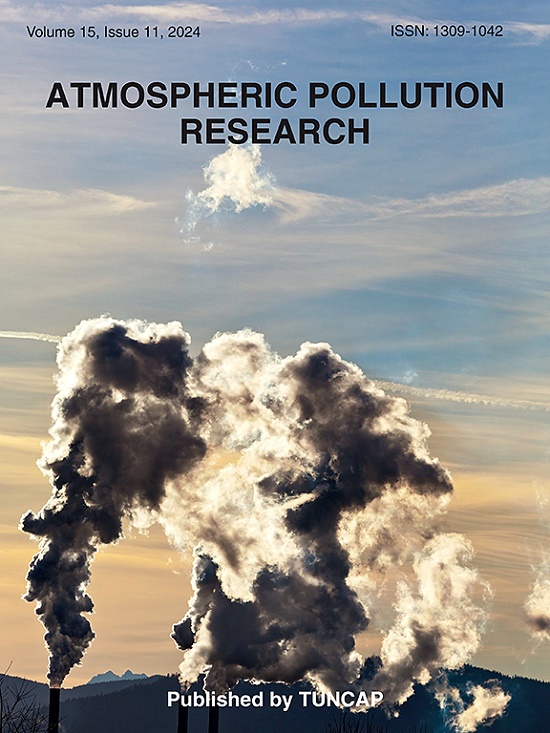Relationship between synoptic meteorology and daily surface O3 variation over China
IF 3.5
3区 环境科学与生态学
Q2 ENVIRONMENTAL SCIENCES
引用次数: 0
Abstract
The diurnal variation of ozone (O3) in China is severely affected by weather processes. In this study, the influence mechanism was further extracted through the coherent wave analysis (CWA) and multivariate empirical orthogonal function (MEOF) methods. The multi-factor time series correlation indicates that there is a significant correlation between the daily O3 and meteorological factors variability within 1–3 weeks. Considering the high-altitude circulation, O3 pollution often occurs behind the trough and in front of the ridge. Under this circulation pattern, hot and dry, less cloudy weather often occurs, which leads to an increase in the level of solar radiation reaching the ground. Higher temperatures and solar radiation promote photochemical reactions, and dry weather is not conducive to the removal of O3 either. These conditions are all conducive to the generation and accumulation of O3 in terms of dynamics, thermodynamics and photochemistry, etc. This further explains that the fluctuations of the mid-latitude westerlies have guided this change process. Atmospheric circulation drives the near-surface weather patterns, which further affect the near-surface O3 patterns. This composite pattern further dominated the diurnal variations in the four key polluted areas. The dominant effect of the T/RH pattern on the diurnal variation of O3 is greater than that of the dynamic field. The leading four PCs of the T/RH/O3 field explain 57.4 %, 43.6 %, 32.9 % and 39.6 % of the NCP, YRD, PRD, and SCB O3 variability, respectively. However, the leading four PCs of the SP/W/O3 field explain 30.3 %, 36.7 %, 12.4 %, and 23.7 % of them, respectively.
中国天气气象与地面O3日变化的关系
中国臭氧(O3)的日变化受天气过程的影响较大。在本研究中,通过相干波分析(CWA)和多元经验正交函数(MEOF)方法进一步提取影响机理。多因子时间序列相关分析表明,1 ~ 3周内的日O3与气象因子变率呈显著相关。考虑到高空环流,O3污染多发生在槽后和脊前。在这种环流模式下,经常会出现炎热干燥、较少多云的天气,这导致到达地面的太阳辐射水平增加。较高的温度和太阳辐射促进了光化学反应,干燥的天气也不利于O3的去除。这些条件从动力学、热力学、光化学等方面都有利于O3的生成和积累。这进一步解释了中纬度西风带的波动引导了这一变化过程。大气环流驱动近地表天气型,进而影响近地表O3型。这一复合格局进一步主导了4个重点污染区域的日变化。T/RH模式对O3日变化的主导作用大于动力场。T/RH/O3场的前4个pc分别解释了NCP、YRD、PRD和SCB O3变异的57.4%、43.6%、32.9%和39.6%。但是,SP/W/O3领域排名前4位的pc分别占30.3%、36.7%、12.4%、23.7%。
本文章由计算机程序翻译,如有差异,请以英文原文为准。
求助全文
约1分钟内获得全文
求助全文
来源期刊

Atmospheric Pollution Research
ENVIRONMENTAL SCIENCES-
CiteScore
8.30
自引率
6.70%
发文量
256
审稿时长
36 days
期刊介绍:
Atmospheric Pollution Research (APR) is an international journal designed for the publication of articles on air pollution. Papers should present novel experimental results, theory and modeling of air pollution on local, regional, or global scales. Areas covered are research on inorganic, organic, and persistent organic air pollutants, air quality monitoring, air quality management, atmospheric dispersion and transport, air-surface (soil, water, and vegetation) exchange of pollutants, dry and wet deposition, indoor air quality, exposure assessment, health effects, satellite measurements, natural emissions, atmospheric chemistry, greenhouse gases, and effects on climate change.
 求助内容:
求助内容: 应助结果提醒方式:
应助结果提醒方式:


